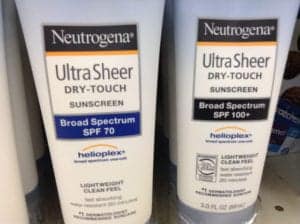When it comes to protecting one’s self from the sun’s rays at the beach, some people prefer “umbrella chic” to sunscreen.
Not only are umbrellas not greasy to the touch, but some people assume the shade provides the best protection possible from the sun. As it turns out, that’s not true, per research published in JAMA Dermatology.

Researcher Dr. Hao Ou-Yang of New Jersey based Johnson & Johnson Consumer, Inc., the maker of many brands of sunscreen, reported that 78 percent of their study sample who used only an umbrella developed a sunburn.
Among the 81 subjects, 41 used only an umbrella and 40 used only sunscreen. Only 25 percent of the participants who used SPF 100 sunscreen received sunburns.
The research was conducted over a few days in August, 2014 in Lake Lewisville, Texas. Beachgoers sustained sunburns to the face, back of neck, upper chest, arms and legs.
The study did have one major limitation: Only one type of umbrella was used from the brand JGC Copa.
“Shade works by physically shielding skin from direct harmful ultraviolet (UV) rays; however, skin may still remain exposed to reflected and indirect UV rays,” according to the study. “A beach umbrella alone may not provide sufficient protection for extended UV exposure. It is important to educate the public that combining multiple sun protection measures may be needed to achieve optimal protection.”
Related: Stem Cell ‘SkinGun’ Could Be Used To Heal Burn Patients
The sunscreen used was Johnson & Johnson’s Neutrogena label. “Participants in the sunscreen group were given pre-weighed tubes of sunscreen.

They were instructed to apply the product liberally to all exposed areas of skin 15 minutes before beach exposure and were instructed to reapply the sunscreen at least every 2 hours or as needed following the directions on the label,” the researchers wrote.
“Participants were instructed to stay at the beach for 3½ hours between 10 AM and 2 PM, but they could leave or stay under a shade for up to 30 minutes for cooling or rest. Sweating was not monitored, but participants were instructed to reapply sunscreen after sweating.” All participants were also told to stay out of the water.
Related: New Technique Could Detect Skin Cancer Without a Biopsy
Protecting your skin from UV rays is important not only to avoid the discomfort of sunburn, but also to prevent skin cancer.

According to the U.S. Centers for Disease Control and Prevention, the sun can damage your skin in just 15 minutes. “You can reduce your risk of skin damage and skin cancer by seeking shade under an umbrella, tree, or other shelter before you need relief from the sun,” the CDC advises on its website. “Your best bet to protect your skin is to use sunscreen or wear protective clothing when you’re outside—even when you’re in the shade.”
More than 3 million people every year in the U.S. are treated for non-melanoma skin cancer, according to the Skin Cancer Foundation. While the melanoma type of skin cancer is much less common, it is deadly and is caused by the sun’s rays. More than 10,000 people died of melanoma in 2016, the Skin Cancer Foundation reported.
A professional journalist nearly 30 years, David Heitz started his career at the Quad-City Times in Davenport, Iowa before moving to Los Angeles. He led the Glendale News-Press to best small daily newspaper in the state (CNPA) as managing editor and also worked as executive news editor of the Press-Telegram. He worked briefly as deputy news editor of the Detroit News before returning to the Quad-Cities, where he has worked as a freelance medical writer since 2012 for several national websites. He recently purchased his childhood home and says he truly is “living the dream.”


![How To: ‘Fix’ Crepey Skin [Watch]](https://cdn.vitalupdates.com/wp-content/uploads/2017/05/bhmdad.png)












